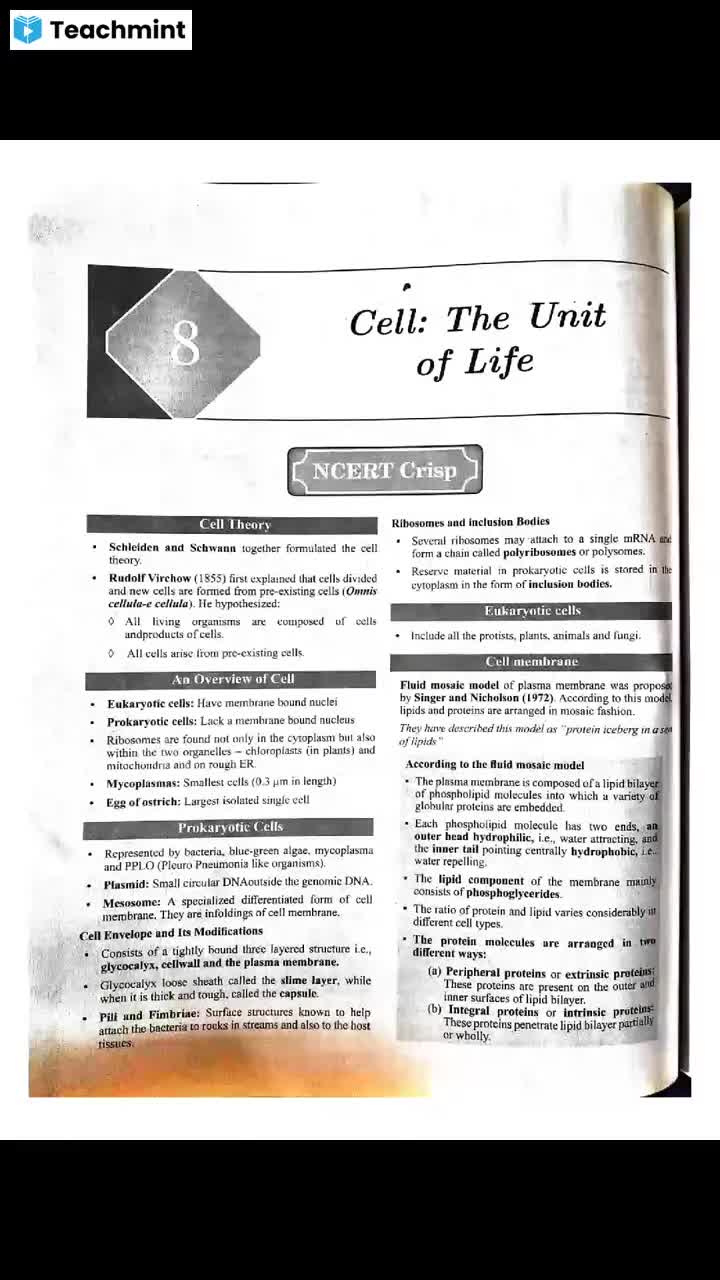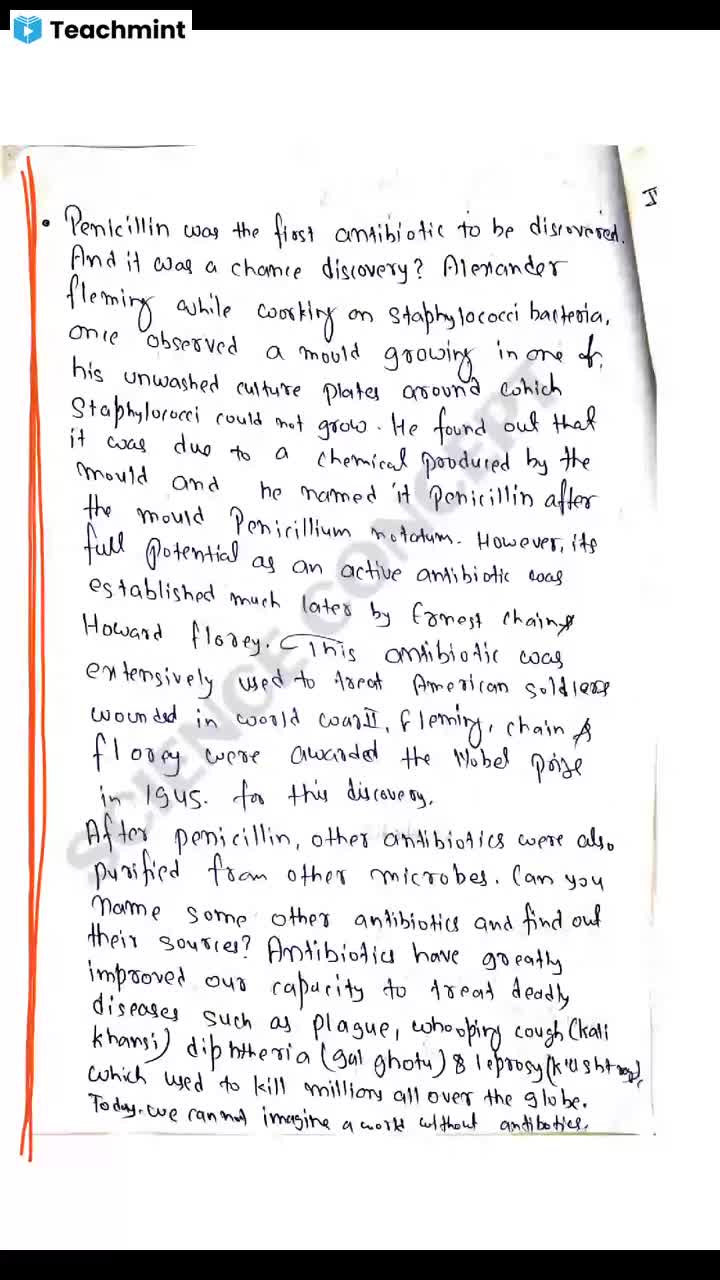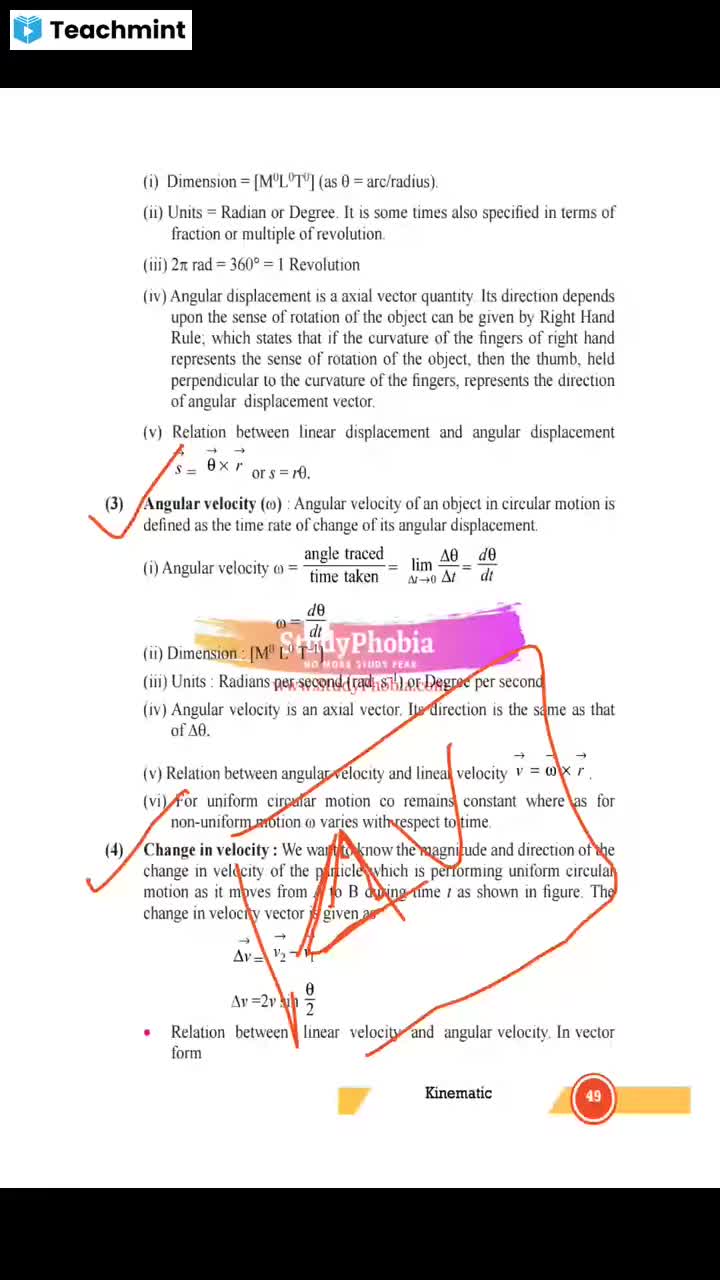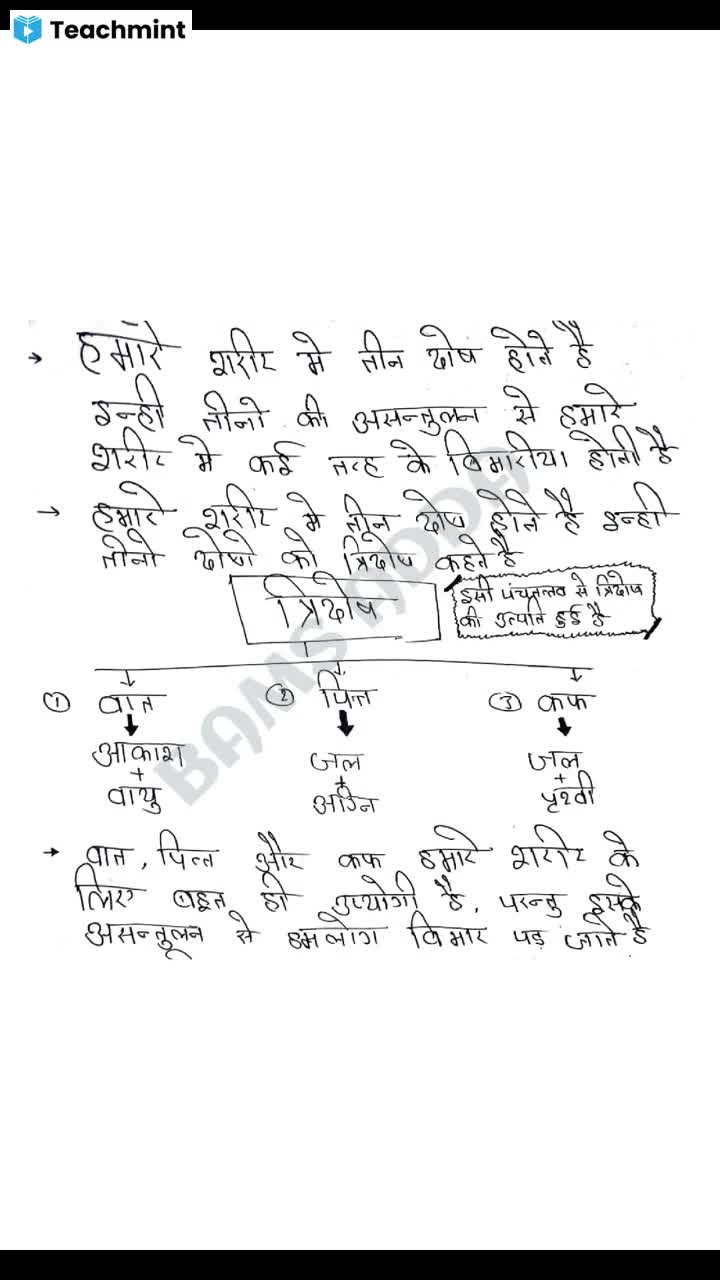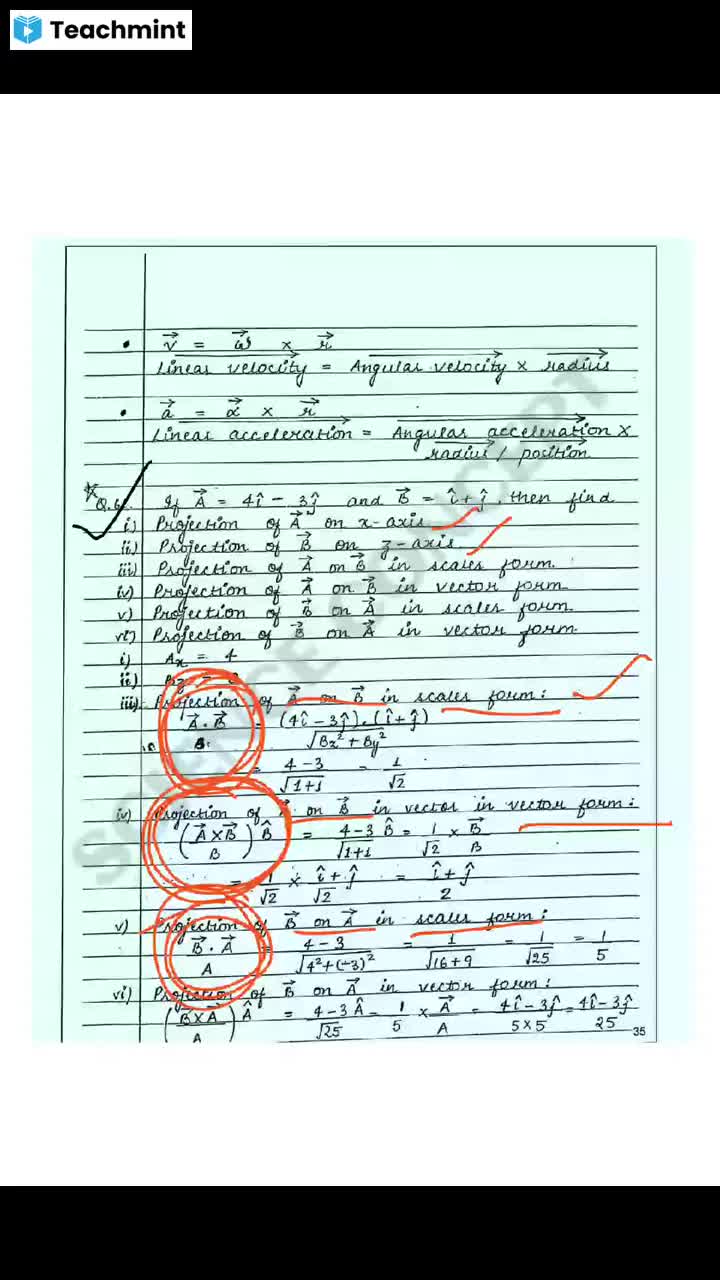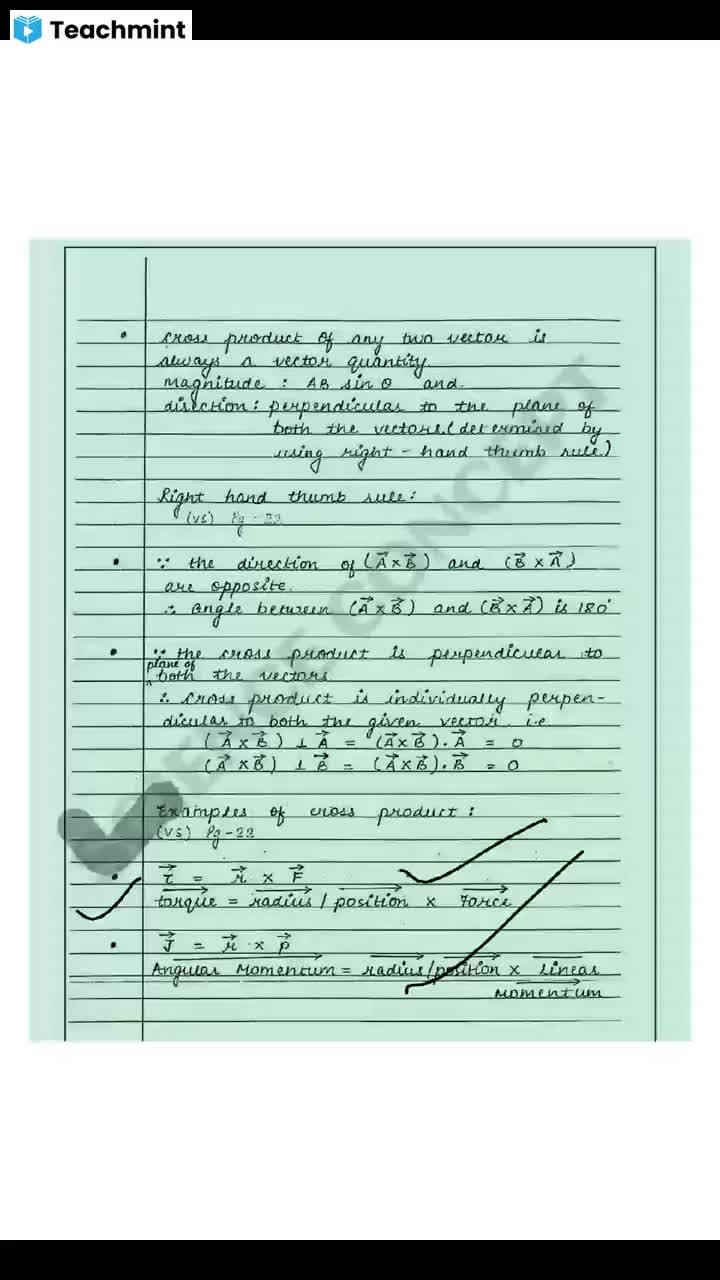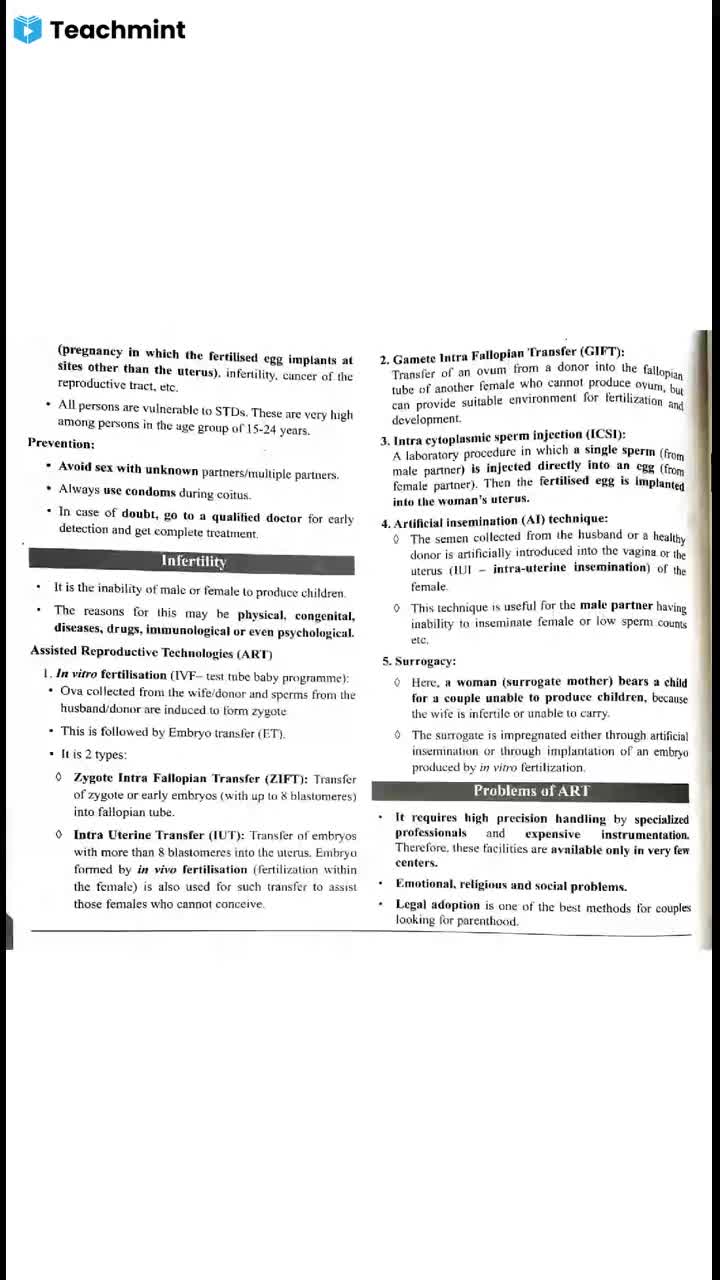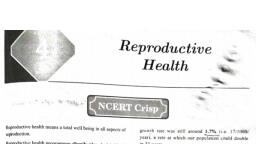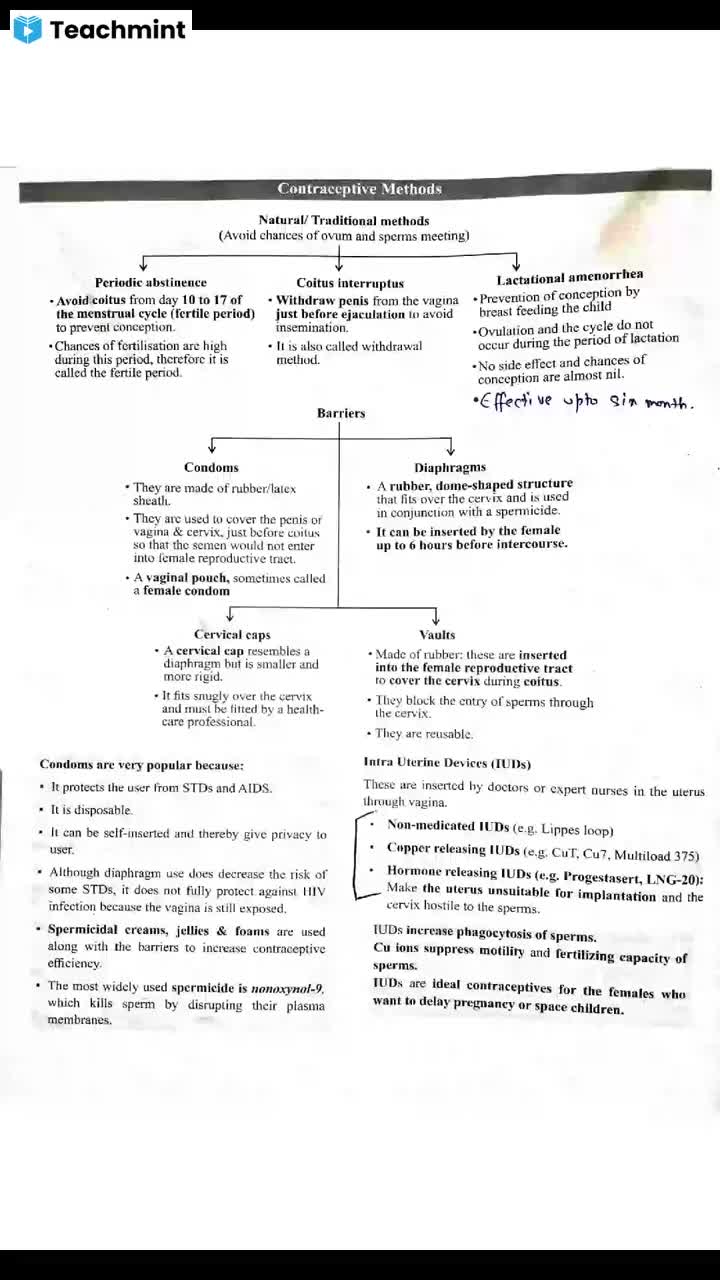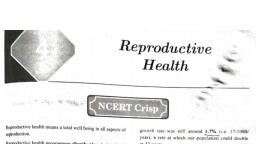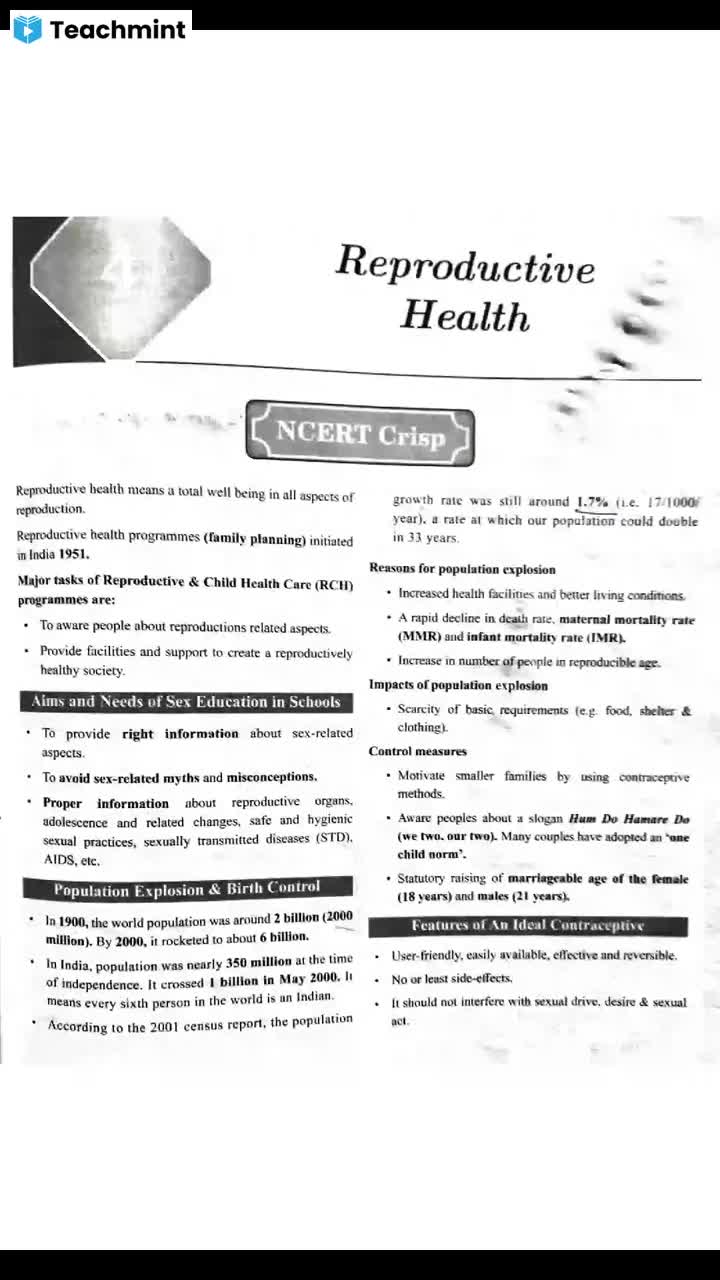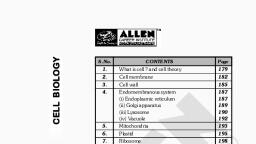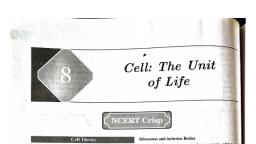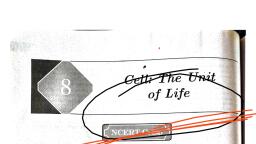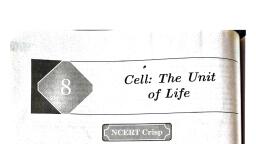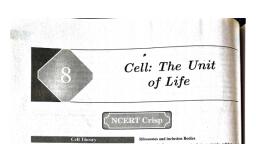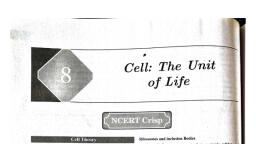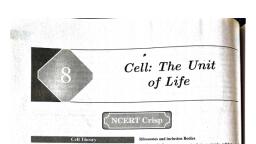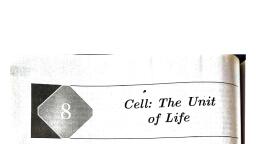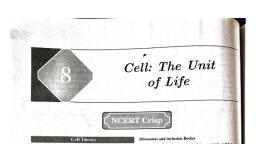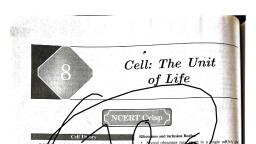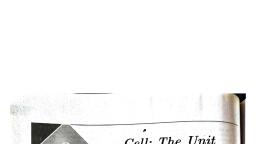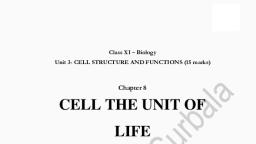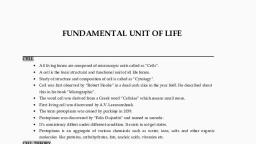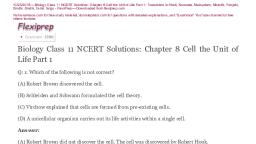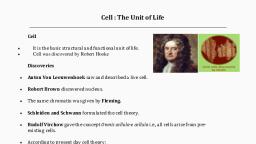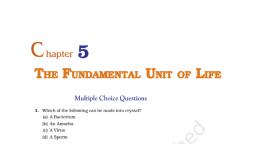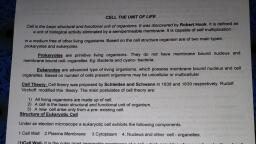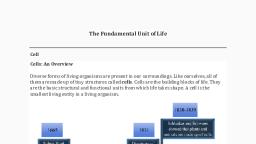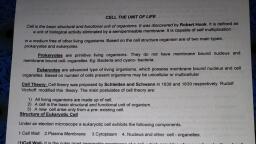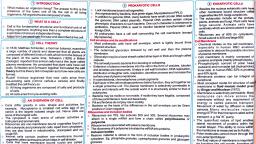Page 1 :
Cell: The Unit, , of Life, , , , , , pe tora, , + Schleiden and Schwann together formulated the cell, theory., , * Rudolf Virchow (1855) first explained that cells divided, and new cells are formed from pre-existing cells (Ommis, cellula-e cellula). He hypothesized:, , ¢ All living organisms are composed of cells, andproducts of cells., , © Allcells arise from pre-existing cells., , * Eukaryotic cells: Have membrane bound nuclei, * Prokaryotic cells: Lack a membrane bound nucleus, , © Ribosomes are found not only in the cytoplasm but also, within the two organelles — chloroplasts (in plants) and, mitochondria and on rough ER., , * Mycoplasmas: Smallest cells (0.3 jm in length), + Egg of ostrich: Largest isolated single cell, , «+ Represented by bacteria, blue-green algae, mycoplasma, and PPLO (Pleuro Preumonia like organisms)., , * Plasmid: Small circular DNAoutside the genomic DNA., Mesosome: A specialized differentiated form of cell, membrane. They are infoldings of cell membrane., _ Cell Envelope and Its Modifications, , ists of a tightly bound three layered structure i.e.,, id cellwall and the plasma membrane., Glycocalyx loose sheath called the slime layer, while, when it is thick and tough, called the capsule,, , , , , , Ribosomes and inclusion Bodies, , , , , , , , , , , , , , , , , * Several ribosomes may attach to a single mRNA’, form a chain called polyribasomes or polysomes., , * Reserve material in prokaryotic cells is stored in, cytoplasm in the form of inclusion badies,, , , , Kukaryotic cells, * Include all the protists, plants, animals and fungz., beet, , Fluid mosaic model of plasma membrane was propo, by Singer and Nicholson (1972). According to this mod, lipids and proteins are arranged in mosaic fashion., , They have described this model as "protein iceberg ina, of lipids", , According to the fluid mosaic model, , * The plasma membrane is composed of a lipid bi i, of phospholipid molecules into which » variety,, globular proteins are embedded. as, , * Each phospholipid molecule has two, outer head hydrophilic, ie., water attractin, the inner tail pointing centrally hydropho!, water repelling., , * The lipid component of the membrane, consists of phosphoglycerides. :, , * The ratio of protein and lipid varies considerabl), different cell types. an, , * The protein molecules in, different ways: <a ig, , fa) Peripheral proteins or extrinsic p, These proteins are present on the outer, inner surfaces of lipid bilayer., , (b) Integral proteins or intrinsic Pp, ‘These proceins penetrate lipid bilayer, or wholly. f easudat
Page 2 :
pynctions, (i) The Pl, ft provides cell shape (in animal cells) “e.g. the, “p racteristic shape of red blood cells, nerve cells, bone, , asma membrane encloses the cell contents, , charac, cells. ete., (iii) It allows transport of certain substances into and out, of the cell but not all substance, so it is termed selectively, permeable., , (iv) Transport of small molecules (such as glucose, amino, acids, water, mineral ions etc.), , ethods of cell transport, , , , , , , , [passive transport Active transport, There is no expenditure of | Requires energy in th, form of ATP, , , , energy, , | Transport of molecules is, the concentration, , Transport of molecules is, , down against the concentration, , gradient, ie., from high to | gradient, i.e... from, low region of concentration. | low to high region of, concentration., , , , , , The active. transport may, also through a carrier, molecule., , Two types:, + Diffusion: E.g., absorption, , of glucose, , , , , , , , , , » Osmosis: aieealissn a}, semipermeable membrane., , Ors VET, , , , , , , , , , , , , , , , , , , * A non-living rigid structure called the cell wa, ‘1 outer covering for the plasma membrane of fungtae, plants. Bacteria and Protista., , , , , , Functions of cell wall, * Cell wall gives shape to the cell, * Protects the cell from mechanical damage and infection, Helps in cell-to-cell interaction and provides barrier to, Undesirable macromolecules., * The cell wall of a young plant cell, the primary wall is, “epable of growth, which gradually diminishes as the, cll matures and the secondary wall is formed on the, t ‘, Mier (towards membrane) side of the cell., , c, Mposition, ‘ Alg, , Cal, , C, , ae 7 i like, , 4e: Cellulose, galactans, mannans and. minerals, , “lum carbonate,, , ‘Pp, lants;, , “M, , pectins and proteins, ctate; holds the, , , , Cellulose, hemicellulose,, , , , , , , , , The endomembrane system include endoplasmic reticulum, (ER), golgi complex, lysosomes and vacuoles., , Endoplasmic reticulum (E.R), , , , * The endoplasmic reticulum is a double unit membrane, structure spread all over the cell and occurs in three, morphological forms viz, cisternae, vesicles and, tubules,, , * In muscles, they are known as Sacroplasmic reticulum., , , , Type of Endoplasmic reticulum, , , , , , , , 3 asmic reticu, , No es on their| Bearing riboso on |, surface. i, , F nm: Major site for} Continuous with the outer, , synthesis of lipid: synthesis | membrane of the nucleus., of lipid-like steroidal, , hormones in animal cells., , , , , , Function: Protein synthesis, and secretion, , , , , , , , , , Golgi Apparatus, as Camillo Golgi (1898), , erve cell in owl. \/, ny figt, di of aped sac$ or cistern¥e, diameter, , acked paratféTo cach othér., , , , , concave frans or the maturing face., + Materials to be packaged 2 the er vesicles from, the ER yAise Axith the =f face of the golgi apparatus, and moye Wwakds the maturikg face. This explains,, why thegolgi apparatus remains in close association, “with the endoplasmic reticul, , , , , , Functions, , Sort and package materials, to be delivered either to the, ed outside the cell., , intracellular targets or secret, , * Modify ribosomal proteins in the cisternae before they, , are released from its trans face., Site of formation of glycoproteins and glycolipids,
Page 3 :
n, s, , Object, , , , ce, (>), B=, j= bis, [ow, =, a, a, io, ie, oe, ie, =, ra, a, , L ‘ ‘, ysosomes are the animal cell’s digestive organelles., , “Lysosomes. contains hydrolases | - lipases, proteases,, , _carbohydrases eerie at helps in digestion of, damaged. material,, , Help in cleaning up the cell by digesting damaged, material of the cell., , When cells are old, diseased or injured, lysosomes attack, their cell organelles and digest them. In other words, lysosomes are autophagic, i.e., self devouring., , The vacuole is the membrane-bound space found in the, cytoplasm., , It contains water, sap, excretory product and other, materials not useful for the cell., , The vacuole is bound by single membrane called, Tonoplast., , ¢ In plant cells, the vacuoles can occupy up to 90 percent, , of the volume of the cell., , * In plants, the tonoplast facilitates the transport of a, , number of ions and other materials against concentration, gradients into the vacuole, hence their concentration is, , significantly higher in the vacuole than in the C¥t0plag,, , In Amoeba, contract, In protists, food vacuoles are formed by engulfing ., , food, , ile vacuole is important for EXcretio,, 1, , ee nonin, , Double membrane-bound structure, , The outer membrane and the inner membrane diy; in, itslumen distinctly into two aqueous compartments, j.¢, the outer and the inner compartment., , The inner compartment is called the matrix., , The outer membrane forms the continuous limiting, boundary of the organelle., , Cristae: Infoldingsin the inner membrane towards, thematrix; increase the surface area., , The matrix possesses single circular DNA molecule., ribosomes (70S) and the components required for the, synthesis of proteins., , Mitochondria are the sites of aerobic respiration. They, produce cellular energy in the form of ATP; hence they, are called ‘power houses’ of the cell., , Acid fuchsin (Triaminotriphenyl methane rosaniline):, It stains parenchyma, cortex, cellulose walls “and, mitochondria., , Plastids are found only in a plant cell and euglenoids. They may be colourless or with colour., , Based on the type of pigments, there are three types of plastids., , , , Leucoplast, , Chromoplast, , a, , Chloroplast, , , , , , , , White or colourless, , Blue, red, or yellow, , Green, , , , , , Their shapes and sizes varies with Contains fat, stored nutrients:, = Amyloplasts, , (starch), e.g., potato., , store carbohydrates, , = Elaioplasts store oils and fats, e.g.,, oil seed, e.g.,, , maize es, , + Aleuroplasts store proteins,, , , , soluble, pigments like carotene, xanthophylls, , carotenoid | Contains chlorophyll and carotenoid, , pigments, , , , whichare responsible for, \trapping light energy essential for, | photosynthesis., , , , , , , , Chloroplast, , * Chloroplasts of the green plants are found in the, mesophyll cells of the leaves., , + These are lens-shaped, oval, spherical, discoid or even, ribbon-like organelles haying variable length (5-10 jum), and width (2-4 um)., , , , * Like mitochondria. the chloroplasts are also double, membrane bound,, , * The inner chloroplast membrane is relatively less, permeable., , * The space limited by the inner membrane of the, chloroplast is called the stroma.
Page 4 :
number of organised flattened, , membranous sg, alle the thylakoids, are present in ay, , , , The membrane of the thylakoids enclose a space called, , lumen., , he stroma of the chloroplast contains enzymes required, for the synthesis of carbohydrates and proteins., , t also contains small, double-stranded circular DNA, Molecules and ribosomes., , hlorophyltl pigments are present in the thylakoids., , he nhosomes of the chloroplasts are smaller (70S) than, sloplasmic ribosomes (80S)., , , , , , , Ute, , bosomes are the granular structures first observed, der the electron microscope as dense particles by, orge Palade (1953)., , y ure composed of ribonucleic acid (RNA) and, oteins and are not surrounded by any membrane,, , are 80S while the prokaryotic, , k, f, ', , F, f, i, , , , , , , , , An claborate network of filamentous proteinaccous structures, , _ Cytoskeleton,, , F Functions of, , 3 * Mechanical support, , 3 Motility, , spe Maintenance of the shape of the cell., , Cilia and Flagella, , , , , , , , , , , , Cilia are small structures causing the movement of cell or, the surrounding fluid,, , Flagella are comparatively longer and responsible for, cell movement., , The electron microscopic study shows that they are, covered with plasma membrane, , Axoneme: The core of ciliwflagella, containing, microtubules running parallel to the long axis., , 9 +2 array: An arrangement of axonemal microtubules, contains nine pairs of doublets of radially arranged, Peripheral microtubules, and a pair of centrally located, microtubules., , The central tubules are connected by bridges and are, enclosed by central sheath, which is connected to one of, the tubules of each peripheral doublet by a radial spoke., , Thus, there are nine radial spokes,, , The peripheral doublets are also interconnected by, linkers., , Centrosomes and Centrio, , Present in the cytoplasm is collectively referred to as the xy, , Centrosome is an organelle usually containing two, cylindrical structures called centrioles., , They are surrounded by amorphous pericentriolar, matenals, Both the centrioles in a centrosome tie, perpendicular to each other in which each has an, organisation like the cartwheel, , , , , , , , , , , , They are made up of nine evenly spaced peripheral fibrils, of tubulin protein,, , Each of the peripheral fibril is a triplet. The adjacent, triplets are also linked., , ‘The central part of the proximal region of the centriole is, also proteinaceous and called the hub, which is connected, with tubules of the peripheral triplets by radial spokes, made of protein., , The centrioles from the basal body of cilia or flagella, and, spindle fibres that five rise to spindle apparatus during, cell division in animal cells,, , , , , , Nucleus as a cell organelle was first described by, Brown (1831)., , The nucleus stained by the basic dyes was given the nan, chromatin by Flemming. 5 “, , Basic fuchsin is used to stain DNA., , Feulgen reagent devised by Feulgen and Rossenbeck., stains nucleic acid of chromosome,, , Acetocarmine stain nucleus.
Page 5 :
aioe nucleus (nucleus of a cell when it is not, , Shee eatieg ighly extended and elaborate nucleoprotein, : chromatin, nuclear matrix and one or more, , spherical bodies called nucleoli (sing: nucleolus),, , a microscopy has revealed that the nuclear, velope, which consists of two parallel membranes with, 4 space between (10 to $0 nn) called the perinuclear, Space, forms a barrier between the materials present, inside the nucleus and that of the cytoplasm., , * The outer membrane usually remains continuous with, , _ endoplasmic reticulum and also bears ribosomes on, mh, , * Nuclear pores are the passages through which movement, of RNA and protein molecules takes place in both, , , , , , , , , , , , directions between the nucleus and the, , The nuclear matrix oF the nucleoplasm, nucleolus and chromatin. ‘, Nucleolus is a site for active ribosomal RNA sy;, Larger and more numerous nucleoli are p csent, actively carrying out protein synthesis., Chromatin contains DNA and some basic pro, histones, some non-histone proteins and also RI Ni, A single human cell has approximately two metn, thread of DNA distributed among its forty six, three pairs) chromosomes., , Every chromosome essentially has primary cons, ‘or the centromere on the sides of which disc si, structures called kinetochores are present. ,, , Based on the position of the centromere, the chromosomes can be classified into four types:, , , , Metacentric, , Sub-metacentric, , Acrocentric, , Telocentric, , , , A middle — centro, mere forms two, equal arms of the, chromosome,, , Centromere slightly, away from the, middle of the, chromosome, , resulting info one, shorter arm and one, , Centromere is, situated close to, its end forming, one — extremely, short and one, very long arm, , Chromosome has, terminal centromere, , longer arm, , , , , , , , , , , , , , * Sometimes a few chromosomes have non-staining secondary constrictions at a constant location, This gives the appearat, , of a small fragment called the satellite,

